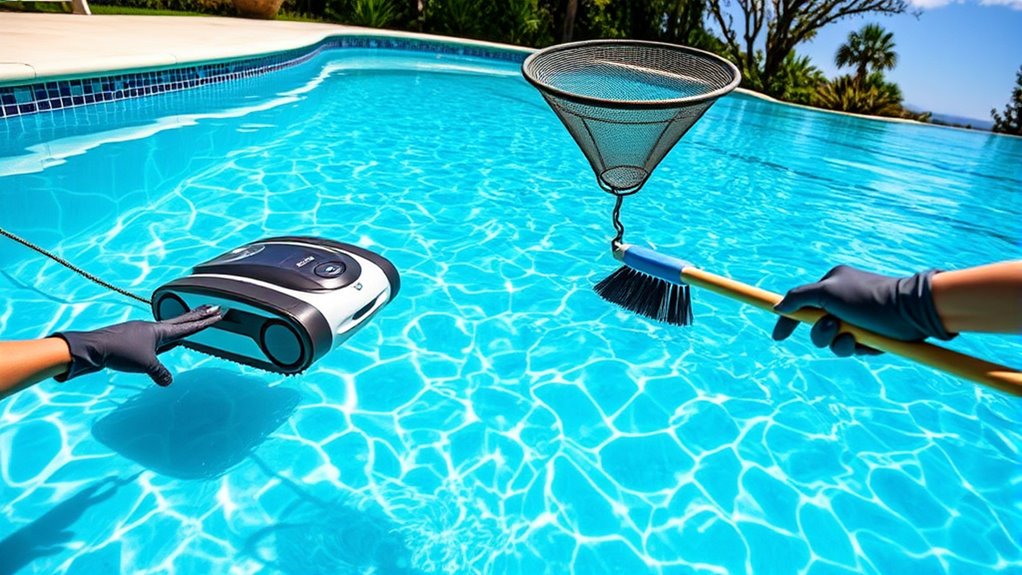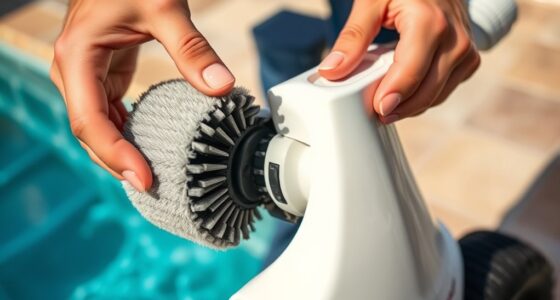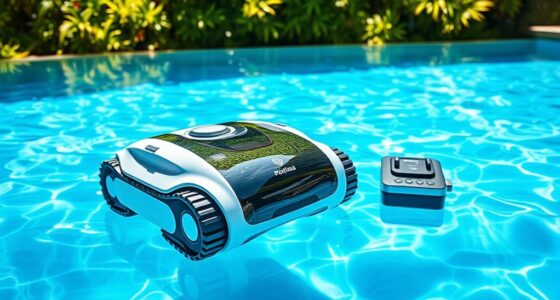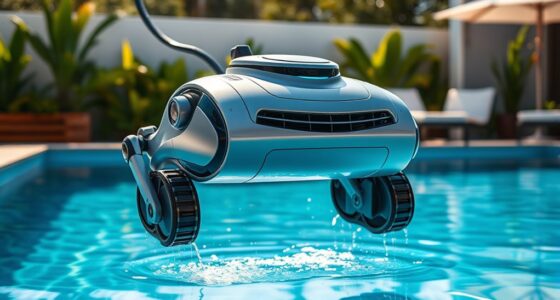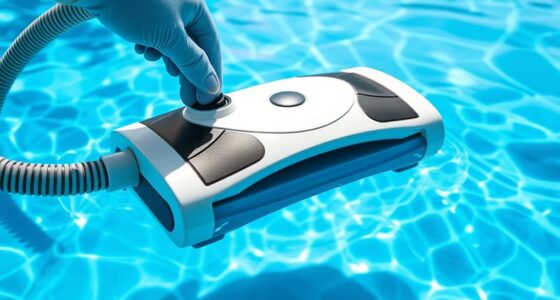Even with automatic pool cleaners, you still need to perform essential manual tasks to keep your pool in top shape. Regularly replacing or cleaning filters guarantees debris doesn’t clog your system and water stays clear. You also need to test and balance chemicals like pH and sanitizers to prevent algae and maintain water quality. These manual steps are key to a healthy, safe pool, and more tips on ongoing maintenance await you.
Key Takeaways
- Regularly inspect and replace filters to ensure optimal water circulation and prevent debris buildup.
- Test water chemistry weekly and adjust pH, alkalinity, and sanitizer levels for balanced, safe water.
- Manually clean pool walls, skimmers, and corners to remove stubborn dirt and algae that automatic cleaners might miss.
- Monitor and maintain chemical levels to prevent algae growth, cloudy water, and equipment damage.
- Perform routine equipment checks, including pumps and filters, to ensure proper functioning and extend lifespan.
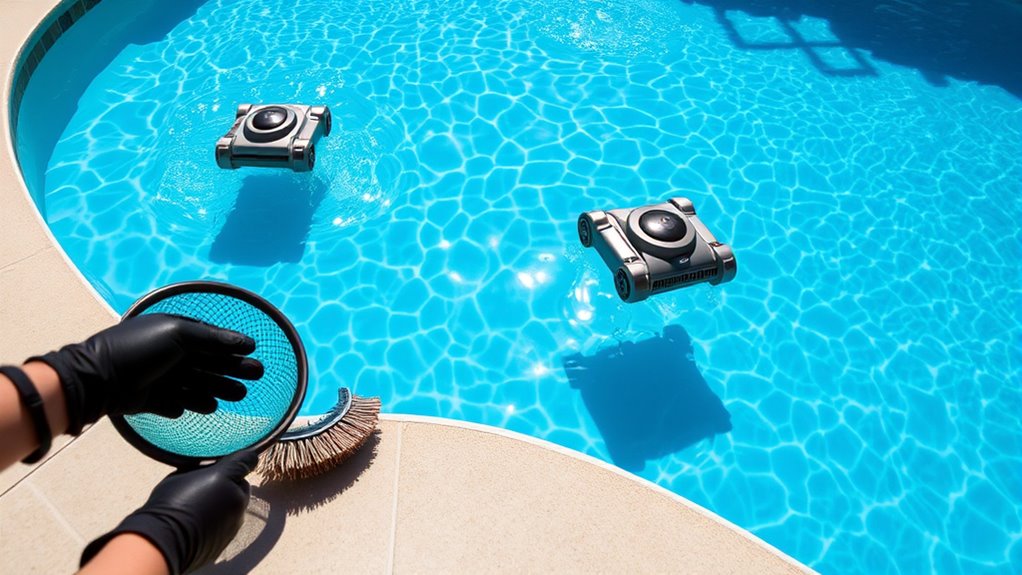
Maintaining a clean and inviting pool can be effortless when you use automatic cleaners. These devices do a lot of the heavy lifting, skimming debris from the surface and scrubbing the walls, but they don’t replace the need for some essential manual tasks. To keep your pool sparkling and safe, you still need to stay on top of filter replacement and chemical balancing. Neglecting these tasks can turn your easy-maintenance routine into a problematic chore.
First, let’s talk about filter replacement. Your pool’s filter is the heart of your cleaning system, capturing dirt, debris, and algae that your automatic cleaner might miss or push around. Over time, filters become clogged or worn out, which reduces their efficiency. Regularly checking your filter’s condition and replacing it when necessary ensures your cleaner functions *crucial*. A clean filter improves water circulation, prevents cloudy water, and extends the life of your automatic cleaner. Depending on your pool size and usage, you might need to replace the filter every few months or more frequently if you notice a drop in water quality or increased debris in your pool. It’s a simple task that can save you time and money in the long run, and it’s *vital* for maintaining clear, healthy water. Additionally, understanding the importance of filter maintenance can help optimize your pool’s overall performance.
Next, chemical balancing plays a *crucial* role in pool maintenance. Automatic cleaners do a good job of removing physical debris, but they can’t manage chemical levels. Proper chemical balancing involves testing your water regularly—at least once a week—and adjusting pH, alkalinity, and sanitizer levels accordingly. This keeps algae growth at bay, prevents cloudy water, and ensures the water feels comfortable on your skin and eyes. If your water’s pH is too high or too low, it can damage your equipment and reduce sanitizer effectiveness. Chlorine or other sanitizers need to be maintained at *optimal* levels to kill bacteria and algae; otherwise, your pool can become a breeding ground for germs. While automatic cleaners help keep the surface clean, they don’t do the work of chemical adjustment. Using test kits and following recommended guidelines makes this process straightforward. Staying consistent with chemical balancing also reduces the workload for your filter and extends the lifespan of your pool’s equipment. Regular water testing and proper chemical management are foundational to effective pool maintenance.
Frequently Asked Questions
How Often Should I Replace My Automatic Pool Cleaner’S Brushes?
You should replace your automatic pool cleaner’s brushes every 6 to 12 months to guarantee maximum performance. Regular brush replacement helps maintain the cleaner’s efficiency and extends its lifespan. Keep an eye out for signs of wear, such as fraying or missing bristles, which indicate it’s time for a new set. Proper maintenance, including timely brush replacement, keeps your cleaner working smoothly and prolongs its overall lifespan.
Can Automatic Cleaners Handle Algae or Heavy Debris Effectively?
You might imagine your automatic cleaner as a tireless helper, but it can struggle with algae control and heavy debris removal. While it handles regular dirt well, algae sometimes cling stubbornly, requiring manual brushing. Heavy debris can clog its filters or overwhelm its brushes. To keep your pool sparkling, supplement your cleaner’s efforts with manual skimming and brushing, especially during algae blooms or after storms.
What’S the Best Way to Store My Automatic Pool Cleaner During Off-Season?
For seasonal care, proper storage tips are essential to keep your automatic pool cleaner in top shape. Before storing, rinse it thoroughly to remove dirt and debris, then let it dry completely. Store the cleaner in a cool, dry place away from direct sunlight and harsh chemicals. make sure it’s in a secure location to prevent damage. Following these storage tips helps extend your cleaner’s lifespan and ensures it’s ready for use when swim season returns.
Do Automatic Pool Cleaners Work Equally Well on All Pool Types?
Automatic pool cleaners don’t work equally well on all pool types. You need to take into account pool surface compatibility and shape considerations. For example, robotic cleaners excel on smooth surfaces like tile or vinyl but may struggle with textured finishes. Likewise, pool shape affects maneuverability; irregular shapes might require specialized cleaners for thorough coverage. Choosing the right cleaner depends on these factors to guarantee ideal cleaning performance for your specific pool.
How Can I Troubleshoot if My Automatic Cleaner Gets Stuck Frequently?
Did you know that 65% of automatic cleaner issues stem from debris buildup? If your cleaner gets stuck often, start by manually inspecting it for tangled cords or obstructions. Remove any debris blocking the brushes or wheels. Regular debris removal and a thorough manual inspection can prevent frequent stalls, ensuring your cleaner works smoothly. This simple step keeps your pool cleaner and your maintenance routine hassle-free.
Conclusion
Even with automatic cleaners doing most of the heavy lifting, you still need to roll up your sleeves for some manual tasks. Regular skimming, brushing, and chemical checks are essential to keep your pool sparkling and healthy. Think of it as tending a garden—automatic tools help, but your attention makes all the difference. Don’t put all your eggs in one basket; a little effort now saves you headaches later and keeps your pool in tip-top shape.
